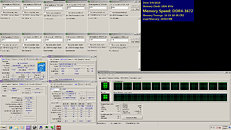Tuesday, May 12th 2015

G.Skill Announces Highest Frequency Ripjaws 4 DDR4-3666MHz Memory Kit
G.SKILL International Enterprises Co., Ltd., the world's leading manufacturer of extreme performance memory, proudly announces yet another extreme speed DDR4 memory kit to the market at a blistering 3666 MHz with only 1.35V. This first-of-its-kind top speed memory kit features a 16GB (4GBx4) capacity and premium class Samsung 4Gb IC chips.
Validated on the Gigabyte X99 SOC Champion motherboard, the Ripjaws 4 series DDR4-3666 MHz memory kit takes the high end desktop X99 chipset platform to new heights in the exciting preparation for the upcoming DDR4 platform.DDR4 memory has come a long way since its release nine months ago in August 2014. With this latest achievement at 3666 MHz extreme memory speed, the full potential processing power of the Intel X99 platform can now be realized. Your ultimate gaming system or workstation can now run smoother than ever as you progress from level to level in-game or switching from workload to workload.
This G.SKILL DDR4 3666MHz 16GB (4GBx4) memory kit comes with the latest Intel XMP 2.0 standard developed for the Intel X99 platform. It provides PC enthusiasts an entirely trouble-free overclocking experience to boost their systems for extreme levels of performance, while retaining system stability.
Limited Lifetime Warranty
All G.SKILL memory products come with a lifetime warranty and the G.SKILL technical team is always ready to provide consumers with complete technical support via online forums, telephone and email.
Validated on the Gigabyte X99 SOC Champion motherboard, the Ripjaws 4 series DDR4-3666 MHz memory kit takes the high end desktop X99 chipset platform to new heights in the exciting preparation for the upcoming DDR4 platform.DDR4 memory has come a long way since its release nine months ago in August 2014. With this latest achievement at 3666 MHz extreme memory speed, the full potential processing power of the Intel X99 platform can now be realized. Your ultimate gaming system or workstation can now run smoother than ever as you progress from level to level in-game or switching from workload to workload.
This G.SKILL DDR4 3666MHz 16GB (4GBx4) memory kit comes with the latest Intel XMP 2.0 standard developed for the Intel X99 platform. It provides PC enthusiasts an entirely trouble-free overclocking experience to boost their systems for extreme levels of performance, while retaining system stability.
Limited Lifetime Warranty
All G.SKILL memory products come with a lifetime warranty and the G.SKILL technical team is always ready to provide consumers with complete technical support via online forums, telephone and email.


10 Comments on G.Skill Announces Highest Frequency Ripjaws 4 DDR4-3666MHz Memory Kit
At present memory clock support on all X99 systems is pretty flaky. There are numerous reasons for this and most of it to do with INTEL and the board partners not quite hitting their stride right in terms of development.
In fact, aggressive DDR4 compatibility testing actually took place, is taking place while the system is in the wild. For instance, for DRAM speeds north side of 3200, the boards do need an OC-Socket. i.e a socket with a greater pin connection than the 2011 that INTEL specified. ASUS was the first to come upon this, but even their compatibility and OC headroom is somewhat limited in comparison to the other vendors that developed their OC-Socketed boards after. Even worse is that the pin count between all three vendors with OC-socket boards is not the same.
3400 and higher will unlikely ever get validated on the RVE. In reality, the newer ASUS boards that came after the RVE have 3400 compatibility (there's only 1 such board I'm aware of).
Annoying that it's the kind of situation that nobody cares to speak about, in addition to several others.
what isn't in that result is that 1. That's an ASUS employee with some tools and software that may not be publicly available. Add to which, that is a very specific CPU that can do that.
2. That's why single channel LN2 results don't say much because, as it stands all 3400 and higher sets do not work on the RVE, but on the Champion and Xpower A with the new socket.
3. There's a reason why all the high speeds are validated on the SOC Champion over and not the RVE. (Geil, G.SKill, Corsair and soon ADATA). Not a multiplier and likely need some adjustments to the board physically.